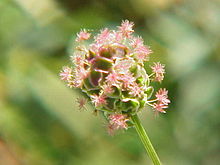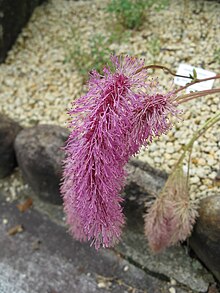Sanguisorba
| Sanguisorba | |
|---|---|

| |
| Flower head of Sanguisorba minor | |
| Scientific classification | |
| Kingdom: | |
| (unranked): | |
| (unranked): | |
| (unranked): | |
| Order: | |
| Family: | |
| Subfamily: | |
| Tribe: | |
| Subtribe: | |
| Genus: | Sanguisorba |
| Species | |
|
See text. | |
| Synonyms | |
| |

Sanguisorba is a genus of flowering plants in the family Rosaceae native to the temperate regions of the Northern Hemisphere. The common name is burnet.
Description
The plants are perennial herbs or small shrubs. The stems grow to 50–200 cm tall and have a cluster of basal leaves, with further leaves arranged alternately up the stem. The leaves are pinnate, 5–30 cm long, with 7-25 leaflets, the leaflets with a serrated margin. Young leaves grow from the crown in the center of the plant. The flowers are small, produced in dense clusters 5–20 mm long; each flower has four very small petals, white to red in colour.
Species
There are about 30 species, including:[1][2]
- Sanguisorba albanica
- Sanguisorba alpina
- Sanguisorba ancistroides
- Sanguisorba annua — annual burnet, prairie burnet, western burnet
- Sanguisorba applanata
- Sanguisorba armena
- Sanguisorba canadensis — Canadian burnet, white burnet
- Sanguisorba caucasica
- Sanguisorba cretica
- Sanguisorba diandra
- Sanguisorba dodecandra — Italian burnet
- Sanguisorba filiformis
- Sanguisorba hakusanensis — Hakusan burnet
- Sanguisorba hybrida
- Sanguisorba magnifica
- Sanguisorba menendezii — Canary Islands burnet
- Sanguisorba menziesii
- Sanguisorba minor — salad burnet, garden burnet, little burnet
- Sanguisorba obtusa — Japanese burnet
- Sanguisorba officinalis — great burnet, burnet bloodwort
- Sanguisorba stipulata
- Sanguisorba tenuifolia — Asian burnet
Ecology
Sanguisorba minor is a food plant for the larvae of the grizzled skipper (Pyrgus malvae) and the mouse moth (Amphipyra tragopoginis).
Cultivation and uses
Burnets are cultivated as garden plants. Many cultivars have been bred, especially from S. officinalis. S. canadensis is grown for its white flowers on stems that well exceed a meter tall. The plants hybridize easily, producing new mixes.[3] S. obtusa is valued for its foliage of pink-edged, gray-green leaves.[4]
S. officinalis is used medicinally in Asia to treat gastrointestinal conditions and bleeding.[5]
Etymology
Sanguisorba means ‘blood stauncher’. ‘Sangui’ is a cognate with ‘sanguine’, meaning 'blood red'. ‘Sorba’ means 'to staunch’. The plant is known to have styptic properties.[6]
References
- ^ Sanguisorba. Flora of China.
- ^ GRIN Species Records of Sanguisorba. Germplasm Resources Information Network (GRIN).
- ^ Sutton, J. Sanguisorba in Cultivation. Archived 2013-08-28 at the Wayback Machine The Plantsman. Royal Horticultural Society. June, 2007. 78-83.
- ^ Bourne, V. How to grow: Sanguisorba. The Daily Telegraph September 21, 2002.
- ^ Choi J, Kim MY, Cha BC, Yoo ES, Yoon K, Lee J, Rho HS, Kim SY, Cho JY (January 2012). "ZYM-201 sodium succinate ameliorates streptozotocin-induced hyperlipidemic conditions". Planta Med. 78 (1): 12–7. doi:10.1055/s-0031-1280219. PMID 21928167.
- ^ Gledhill, David (2008). The Names of Plants. MCambridge University Press. p. 339. ISBN 9780521866453.
